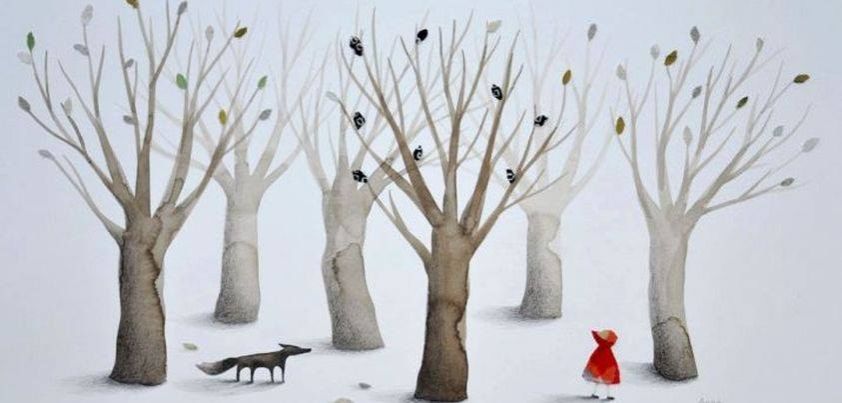 This time last year we featured Charles Perrault’s famous interpretation of an ancient folktale, Cinderella. Today we have another well-known Perrault story, Little Red Riding Hood. The version of the story most commonly told today is from a Brothers Grimm adaption known as Little Red Cap, published over 100 years after Perrault. In both versions, Red is punished for talking to strangers (the wolf) by being “eaten”. The Brothers extended the story to make it more appealing to children. In addition to Red and her grandmother miraculously surviving in the wolf’s stomach, they later meet and kill a second wolf.
This time last year we featured Charles Perrault’s famous interpretation of an ancient folktale, Cinderella. Today we have another well-known Perrault story, Little Red Riding Hood. The version of the story most commonly told today is from a Brothers Grimm adaption known as Little Red Cap, published over 100 years after Perrault. In both versions, Red is punished for talking to strangers (the wolf) by being “eaten”. The Brothers extended the story to make it more appealing to children. In addition to Red and her grandmother miraculously surviving in the wolf’s stomach, they later meet and kill a second wolf.
Little Red Riding Hood Original Text / PDF (666 words)
Little Red Cap Original Text / PDF (1,382 words)
General Comments
Our source for Little Red Riding Hood was an English version of the Perrault story published in The Blue Fairy Book, one of a series of twelve collections of folk and fairy tales for children edited by Andrew Lang. This is the first book in the series, and was first published in 1889. The book contains translations of seven Perrault stories, but omits an important aspect of each: Perrault’s morals. For Red Riding Hood, this is:
Children, especially attractive, well bred young ladies, should never talk to strangers, for if they should do so, they may well provide dinner for a wolf. I say “wolf,” but there are various kinds of wolves. There are also those who are charming, quiet, polite, unassuming, complacent, and sweet, who pursue young women at home and in the streets. And unfortunately, it is these gentle wolves who are the most dangerous ones of all.
Our source for Brothers Grimm stories is the Household Tales 1884 translation by British writer Margaret Hunt. The book contains all 200 Grimm folktales plus 10 legends; Little Red Cap (Rotkäppchen) is tale No. 26. The Grimms listed their source for the story as German sisters Jeanette and Marie Hassenpflug. Its moral is expressed more cryptically in this sentence from the story:
Red-Cap thought to herself, “As long as I live, I will never by myself leave the path, to run into the wood, when my mother has forbidden me to do so.”
Folklore Origins of the Story
Although we have Perrault to thank for the first written version of Red Riding Hood, the folktale originated long before he was born. The following is a simplified extract from the newspaper article Fairytales Have Ancient Origin by Science writer Richard Gray, which recently appeared in the U.K.’s Daily Telegraph.
Dr Jamie Tehrani from Durham University studied 35 versions of Little Red Riding Hood from around the world.
Whilst the European version tells the story of a little girl who is tricked by a wolf pretending to be her grandmother, in the Chinese version a tiger replaces the wolf. In Iran, where it would be considered odd for a young girl to walk about alone, the story features a little boy.
Dr Tehrani found that all the stories shared a common ancestor dating back more than 2,600 years and commented: “Over time these folktales have evolved just like natural organisms. Because many of them were not written down until much later, parts may have been forgotten and reinvented through hundreds of generations. Looking at how they have spread and changed tells us something about human psychology and what sort of things we tend to remember.”
Dr Tehrani identified 70 variables in plot and characters between different versions of Little Red Riding Hood. He found that the stories could be grouped into clearly identifiable families according to how they evolved over time.
The original ancestor is thought to be similar to another tale in which a wolf pretends to be a mother goat to get entry to a house full of young goats. Stories in Africa are closely related to this original tale, whilst stories from Japan, Korea, China and Burma form a sister group. Tales told in Iran and Nigeria were the closest relations of the modern European version.
Dr Tehrani added: “We don’t know very much about how these stories moved from culture to culture, but it is possible that they may have been passed along trade routes or with the movement of people.”